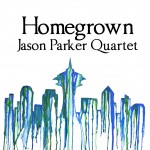by Katy Bourne

Guitarist Shohei Kuba Ogami came to jazz by way of the blues, or more specifically, by way of Stevie Ray Vaughan. Shohei was just 15 years old and had recently moved from Kakogawa, Hyogo in Japan to Seattle with his mother and stepfather. Two months prior to the move, his father, a former metal guitarist, gave Shohei a guitar and showed him some of the basics. Stuck in an unfamiliar city with several months to kill before starting school, the young teenager took to practicing his new instrument and watching guitarists on You Tube. It was here that he discovered Stevie Ray Vaughan. “I thought he was a guitar god,” he muses. Shohei watched every performance clip that he could find and learned all of Vaughan’s songs. He even bought a Wyatt Earl style cowboy hat just like his idol wore. He was enraptured by Vaughan and by the blues. He was particularly struck by the emotionally expressive nature of the blues and by the immediacy. He decided to go deeper, listening to delta and country blues and artists such as Lightning Hopkins, Robert Johnson and Danny Gatton. When he came across a recording of Vaughan playing Kenny Burrell’s tune, “Chitlins con Carne,” the connection between blues and jazz became clear to Shohei, “I decided to listen to jazz so I could become a better blues player.”
After his summer of You Tube and guitar videos, Shohei started high school at the Northwest School. He decided to join the school jazz band and asked the bandleader Jim Sisko what he needed to know in order to play with the band. Sisko answered that he needed to be able to read chord symbols and drew a “C-” on the chalkboard. “I suffered over that for a week,” Shohei recalls, “I had no clue what that was. And then I figured I should study music.” He began studies with Cornish alum Zach Stewart, who taught him the basics such as music theory, sight reading and the “nuts and bolts of guitar.” Things began to gel for Shohei but playing jazz was a big change: “Jazz guitar is more restricted– at first it felt that way. There are more rules to play by.” Ironically, Shohei ended up playing electric bass in the school jazz band. There were several good guitarists in the band but no bass players. Shohei was assigned the role. When he tried to get more input from his bandleader as to what this would entail, Sisko replied, “Don’t use a pick. Bring down the tone nob. OK, you’re a bass player.”
 Shohei continued to play and study, “faking jazz for awhile,” as he puts it. He was listening to lots of jazz but says, “I didn’t really get smashed in my face by jazz like the blues had.” However, when he heard a recording of Charlie Parker’s “Confirmation,” all that changed. “Oh my God, it that gave me the shivers. It was so good. I finally understood what swing was, what jazz was about. Before I didn’t really know where I was heading.” After this epiphany, Shohei had a focus. He picked up a Real Book and started learning tunes. Around this time, Shohei met Seattle guitarist Milo Peterson at the Shoreline Jazz Camp and started studying with him. This would prove to be another pivotal point in his development as a jazz artist. “This was a whole different experience because Milo is a jazz purist in so many ways,” he recalls, “That’s when I really started learning the traditions and aesthetics of jazz. My improvising started sounding kind of like jazz. I stopped using blues licks. I purchased a jazz guitar.”
Shohei continued to play and study, “faking jazz for awhile,” as he puts it. He was listening to lots of jazz but says, “I didn’t really get smashed in my face by jazz like the blues had.” However, when he heard a recording of Charlie Parker’s “Confirmation,” all that changed. “Oh my God, it that gave me the shivers. It was so good. I finally understood what swing was, what jazz was about. Before I didn’t really know where I was heading.” After this epiphany, Shohei had a focus. He picked up a Real Book and started learning tunes. Around this time, Shohei met Seattle guitarist Milo Peterson at the Shoreline Jazz Camp and started studying with him. This would prove to be another pivotal point in his development as a jazz artist. “This was a whole different experience because Milo is a jazz purist in so many ways,” he recalls, “That’s when I really started learning the traditions and aesthetics of jazz. My improvising started sounding kind of like jazz. I stopped using blues licks. I purchased a jazz guitar.”
Read More




